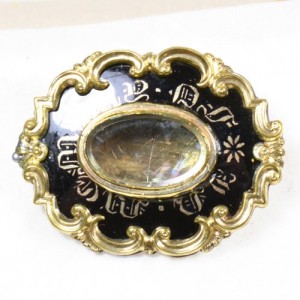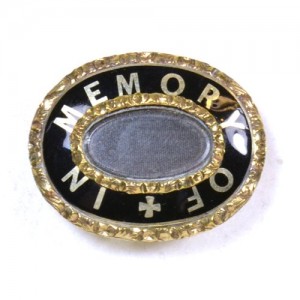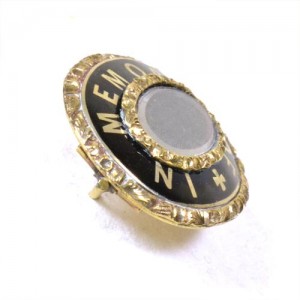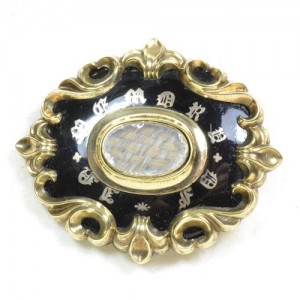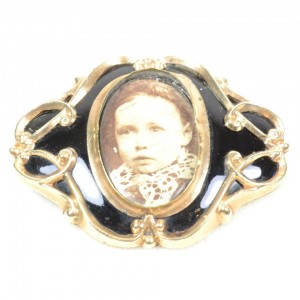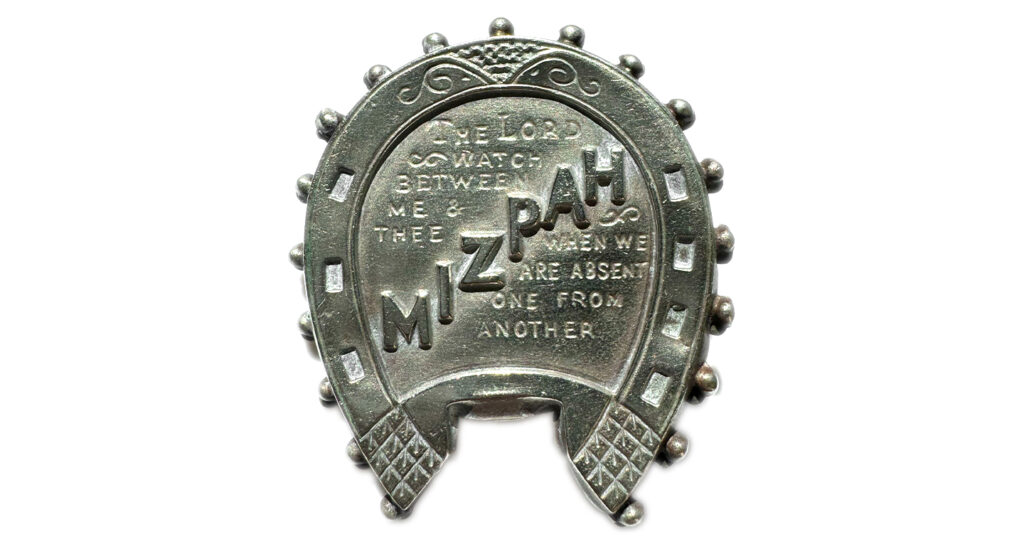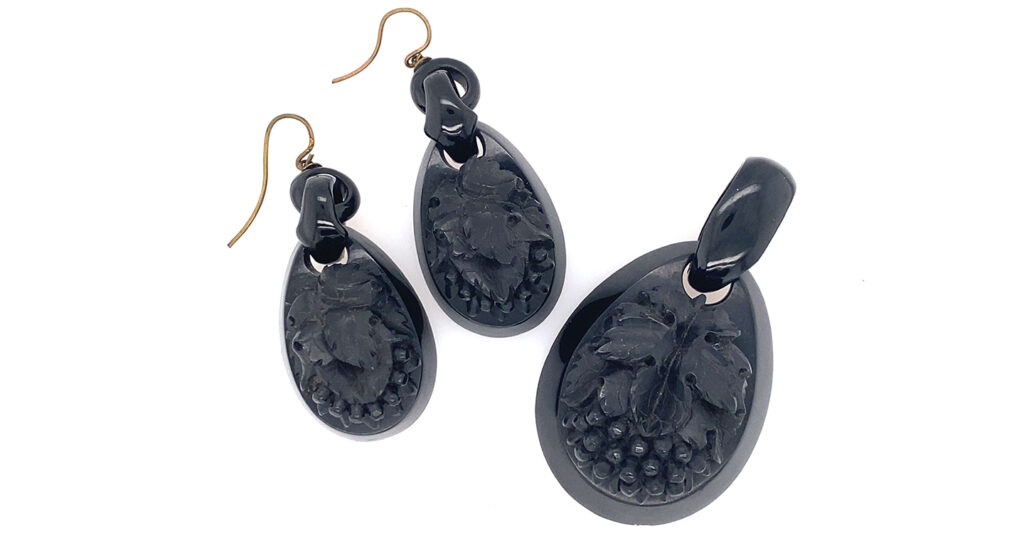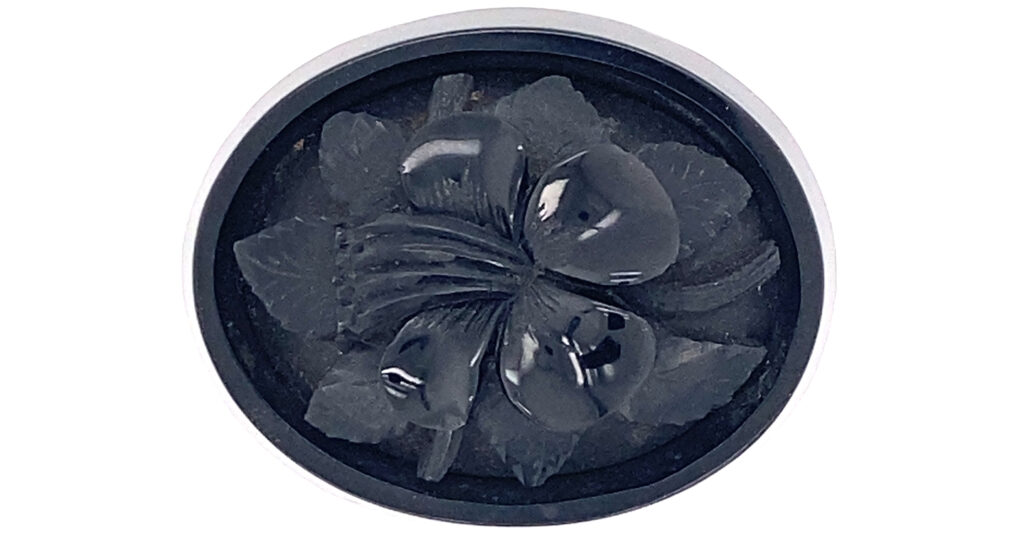The Mourning Brooch Standard, Early-Mid 19th Century
Mourning jewels are easy to identify for their purpose. It is within the sentiment of a jewel that one can discover the continuity of a short period in time, simply through design and stylistic choices. Looking at several brooches with very similar styles, we can see the two unified with their construction, dedication and purpose over the 1830s to 1860s.
The use of similar styles in mourning jewellery can connect pieces over several generations in their style. Since the inception of the industry in the late 17th century, the fundamentals of hair, or a token of the loved one, a written inscription and over symbolism in a statement depiction or enamel clearly make the jewels from the 17th-20th centuries easy to define. But, when we look to short periods of time within a century, a time where there was much change in society and art, we begin to see these values reflected back into the jewellery.
In Memory Of
A statement such as ‘In Memory Of’ is one of the most powerful mourning sentiments and one that connects these pieces. Both would be worn at the next or bodice at a time when fashion was adapting to larger style of jewels, hence the statement of the obvious ‘In Memory Of’ is one that could be seen by the viewer.
What is important about the earlier brooch is the attention to the Rococo details that had made a resurgence in popularity through the Gothic Revival in the border, with the elaborate acanthus design creating the grandeur to the very stark interior. A similar style can be seen in the contemporary piece below:

Design becomes larger & more elaborate
From the previous clean, geometric ovals and rectangular shapes with very little embellishment from the 1800-1820 period, this switch to earlier values was quite profound. This move back to the earlier Gothic styles was a reaction to religious non-conformity in an effort to swing back to the ideals of the High Church and Anglo-Catholic self-belief.
This was a time when heavy industry was on the rise and modern society (as we consider it today) was established, a time of radical change that challenged pre-existing ideals of society. Though there had been growing small scale social mobility from the late 17th century, the late 18th and early 19th centuries saw the middle classes having the opportunity to promote through society with the accumulation of wealth.
Augustus Welby Northmore Pugin, a designer, architect and convert to Catholicism, saw this industrial revolution as a corruption of the ideal medieval society. Through this, he used Gothic architecture as a way to combat classicism and the industrialisation of society, with Gothic architecture reflecting proper Christian values. Ideologically, Neoclassicism was adopted by liberalism; this reflecting the self, the pursuit of knowledge and the freedom of the monotheistic ecclesiastical system that had controlled Western society throughout the medieval period.
Consider that Neoclassicism influenced thought during the same period as the American and French revolutions and it isn’t hard to see the parallels. The Gothic Revival would, in effect, push society into the paradigm of monarchy and conservatism, which would dominate heavily throughout the 19th century and establish many of the values that are still imbued within society today.
Within the context of these brooches, the dominant, black enamel signifies death quite boldly and the ‘In Memory Of’ states the subject in mourning, rather than being an opulent setting of romantic idealism. It relates to the values of being judged by God and living one’s life in piety for another. Family values that are captured in this message relate to the uniformity and solidarity of the family unit as well as longevity through the memory of the departed person. At a time when the mortality rate was about forty years old, many women would be wearing the trappings of mourning for much of their lives in the 19th century.
Here, the ‘In Memory Of’ statement has taken on the Gothic Revival style with the most obvious look towards design. The use of the Gothic Script is overtly Gothic and a great element for a modern audience to identify similar jewels. Embellished borders and Gothic script appeared in all manner of jewellery from the 1820s-40s. Much of the latter 19th century pieces had their origin in this Gothic Revival period, the bold styles with black enamel as well as being larger accommodated the evolution of female fashion, which heavier crinolines and cuffs, seemed to be a perfect fit. Styles didn’t automatically become larger due to the Gothic Revival influence, much of the older styles adapted Rococo acanthus designs and incorporated Gothic fonts into the lettering of the dedication in the pieces, which emerged around the c.1800-1810. By the 1820s this style was influencing brooches, rings, pendants and lockets more and more, until the 1830s when it reached its height, particularly in terms of diversity. Through the 1840s it had become the standard and into the 1850s, there was the Hallmarking Act of 1854 that allowed the use of lower grade alloys. Reflecting this upon the larger styles of female dress, pieces could be larger and lighter to wear, yet still give all the bold, gold and black enamel prominence of the pieces themselves.
In the latter brooch, we see the Victorian standardisation of the form. Gone are the embellished Gothic elements, but the retention of the style creates a cleaner, bolder ‘In Memory Of’ statement. As one can see, the elements to the border have been reduced, with the finer floral design retained. This was also taken from the Gothic Revival style, as can be seen in the below ring;
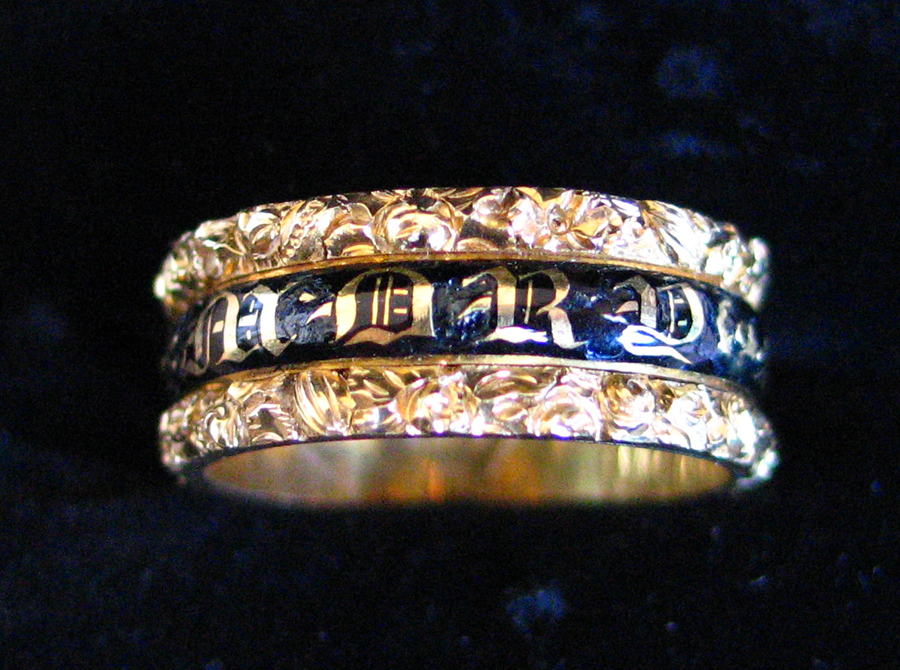
Appearing on other jewels
While some have called the above ring a ‘pie crust’ due to the floral border, this style came about during the 1810s and was a reflection back upon the Gothic Revival style. As the latter brooch dates from around the mid-19th century, the continuity over a forty year period is obvious. The use of the cross separating ‘Of’ and ‘In’ is one that reflects the times, with a push back to Christian values during the 1840s and since Victoria’s establishment of the Victorian family.
The 1820s to 1860s
Using these brooches, we can tie together the 1830s and the 1840s, simply by their elements. As we have seen with the ‘In Memory Of’ statement and its development/relation to the Gothic Revival, the smaller elements of each brooch and their refinement in time are reflective of the society which produced them.
In this brooch, we can see the smaller attention to the ‘In Memory Of’ style within the size of the larger brooch The hairwork is basically woven underneath, while the acanthus border is almost overtaking the piece itself. Compared to the below piece, the statement is gone completely, with a simple twist of hair being placed under the glass:
By the 1850s, many of the styles developed in the 1840s remained. 1854 saw the Hallmarking Act which allowed for lower grade alloys to be used in jewellery construction, hence the larger brooches in these styles being utilised. they were light to wear and balanced well with the voluminous crinoline. By the time we reach the 1860s, styles had been refined down to the previously discussed brooch:
The clear continuity between all of these brooches reflects upon much of the standardisation bought about through a uniformity in society. These brooches cover a period of up to forty years and when looking back at the period of 1760-1800, the vast change of the Neoclassical period from the Rococo (and the Neoclassical period’s changes within itself) are rapid, with styles changing dramatically between year to year. But what were the social elements that made these brooches to standard?
In the 1820s, many influences upon society offered greater cultural flexibility within the social structure. The excesses of George IV and his investment in the arts bought new influences into the United Kingdom. From the death of Princess Charlotte who died in 1817, mortality was absorbed as a cross-cultural, kingdom-wide event, imposing values of the affectations of mourning on people which would resonate for the remaining 19th century. The values that were appropriated to show this in fashion led to the Gothic Revival being the identifier for grief and virtue, due to its return to religious values and simplicity that takes that pomp away from the fact of death.
Following into Queen Victoria’s early reign, it was innovation led by Albert, Prince Consort who helped impose many of the Victorian standard values upon society. The Great Exhibition of 1851 came about during a time of European and Latin American economic turmoil in 1848, leading to revolutions following the rise of nationalism. Albert’s dedication towards acknowledging the underprivileged and offering financial and educational assistance was an incredibly bold stance for the time, particularly when his family in Europe was being threatened. Since 1843, Albert was President of the Society of Arts, which, from its annual exhibition, became the basis for the Great Exhibition. Based in Hyde Park within The Crystal Palace, the value of science, art and industry became a matter of pride for British society, which is a progressive step and one that shows the great innovation of Albert, himself. As a counter to revolution, The Great Exhibition stood fast and as a catalyst for art and innovation, the impact upon jewellery design that was revealed through new techniques of metallurgy and style resonated back through society.
Technologically, the brooch, with its ability to morph shape and size, was also a popular conveyance for new technologies. As seen in the below brooch, photograph was used within the similar style of brooch:
This was a way in which many mourning and sentimental jewels could still stay relevant in changing times. Whereas portraits and hair took prominent place within jewels and keepsakes, the better technologies that led towards cheaper and smaller photographs gave way for greater accessibility between different class levels for photographic jewels. More on this can be read in the following articles:
Further Reading:
> Photography in Jewellery Part 1
> Photography in Jewellery Part 2
> Photography in Jewellery Part 3
> Photography in Jewellery Part 4
> Photography in Jewellery Part 5
> Photography in Jewellery Part 6
> Photography in Jewellery Part 7
Mourning Fashion
As stated, these brooches would be worn at the neck or bodice and conform to high morning fashion, while more commonly being worn after Ordinary stage of mourning for the perpetuity of the life of the wearer, if chosen to. Many of these pieces have remained in perfect condition, as produced pieces would be stored away and not worn, but kept as a keepsake for the loved one. Several may have been produced for one deceased person, with the bequeathment having funds in the will to produce enough mourning jewels for female family members. This comes from the requirement of mourning being a necessity within the family to present themselves in mourning. A person would work their lives and give a portion of their wages to a Burial Society for the benefit of a proper funeral and the trappings of mourning to be provided for the family.
Mourning regulation went through different permeations in the 19th century and became longer and more rigid. It was on the 7th of November, 1817 upon the death of Princess Charlotte that Lord Chamberlain ordered official Court mourning: ‘the Ladies to wear black bombazines, plain muslins or long lawn crape hoods, shammy shoes and gloves and crape fans. The Gentlemen to wear black cloth without buttons on the sleeves or pockets, plain muslin or long lawn cravats and weepers [white cuffs] shammy shoes and gloves, crape hatbands and black swords and buckles.’ For undress wear, dark grey frock coats were permissible. The Second stage was decreed two months later, with the allowance of black silk fabric, fringed or plain linen, white gloves, black shoes, fans and tippets, white necklaces and earrings, grey or white lusterings, damasks or tabbies and lightweight silks for undress wear. Men’s dress was unchanged. The third stage allowed women to wear black silk and velvet, coloured buttons, fans and tippets and plain white, silver or gold combination coloured stuff with black ribbons. Men could wear white, gold or silver brocaded waistcoats with black suits. The rules set by Lord Chamberlain crossed Europe, the United States (from the 1860s / 70s) and colonial territories, but Court mourning was longer than General mourning. General mourning was growing in popularity due to the accessibility of mourning costume and the cost.
For the stages of mourning, one of the most important factors is colour. For example, turquoise was often used as a during the half half morning stage, post Third Stage (or Ordinary stage) as a mourning material, with its influx of colour. This stage was introduced after twenty-one months, involving the omission of crape, inclusion of black silk trimmed with jet, black ribbon and embroidery or lace were permitted. Post 1860, soft mauves, violet, pansy, lilac, scabious and heliotrope were acceptable in half mourning. This period lasted three months.
The English Woman’s Domestic Magazine stated that ‘many widows never put on their colours again’ and this was quite a statement for the identity of the woman, which was held under the veil of mourning and family symbolism for the rest of her life.
A Lasting Message
While style was defined in the 19th century for mourning, these brooches are easily identifiable today as being for the purpose of mourning. From the use of black enamel to the stylised ‘In Memory Of’, each piece resonates the same quality of sentimentality that would still be used today in funerary art. Though this only takes in the first portion of the Victorian Era, there are many cultural permutations of the black enamelled brooch across continents and lasting well into 1900.




